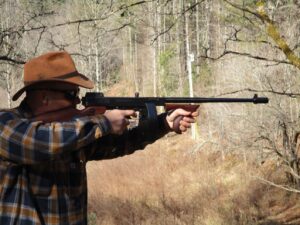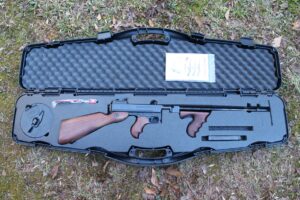By Jim Dickson | Contributing editor

My first glimpse of the semi-auto version of the Thompson submachinegun was a 1967 picture of Colonel Charles Askins holding one in a gun magazine.
As a longtime lover of the Thompson I knew I had to have one. It turned out to be a long wait. Auto-Ordnance was owned by Numrich Arms and George Numrich was the one who wanted a civilian legal version. However, it was not until 1974 that a prototype was submitted to BATF for approval and it was not approved until March 1975.
While the original Thompson submachinegun fired from an open bolt thereby eliminating 50% of the recoil and any chance of a hot barrel cooking off a round in the chamber BATF would only approve a closed bolt firing gun so the gun was designed to fire from a closed bolt. The semi-auto version is a straight blow back design dispensing with the Blish lock of the originals as well as the oil pads inside the receiver.
The BATF demanded that the gun not use original Thompson magazines so the magazine catch was modified and the magazine hole for the catch was enlarged. Many people simply had the new magazine catches modified for the original surplus magazines.
A .22 conversion kit was brought out as an accessory just as the M1911A1 pistol has its conversion kits for inexpensive shooting. There was also a version made in .22-caliber from the ground up.

A pistol version which mimicked the appearance of the original Thompson minus the stock was brought out with the original barrel length instead of the 16-inch barrel length mandated by the government for civilian sales of rifles.
An aluminum receiver and frame marked the lightweight version for those who wanted ease of carry more than the steadiness of the heavier steel version.
There was also a semi-auto version of the M1 Thompson, the cheaper version developed by Savage Arms in WW2.
As the 10MM cartridge became popular a 10MM chambering of the Thompson was introduced in the 1980’s so 10MM users could have a pistol and long arm of the same caliber.
In 1999 Kahr Arms bought Auto-Ordnance and began producing the Thompson. Over the years there have been the following improvements:
- The prints were computerized and all new parts were employed. Most of these are made on modern CNC machines.
- New stamping rollers were made so the markings are clearer.
- All wooden parts are newly made to the original design and the original paddle type safety and knob bolt handle were brought back.
- Guns were given a higher grade of finish and all new magazines were fabricated.
- Today you can buy 10, 20, and 30 round stick magazines as well as 10, 50, and 100 round drum magazines.
- Specialty models are available for commemoratives as well as engraving.
When I picked up the test rifle for this article at Reeves Ace Hardware in Clayton, Georgia it was reminiscent of meeting an old friend again. After all, I had one of the first ones ever made in 1975. Fit and finish was flawless and the trigger pull broke clean at 10 ½ pounds as measured with a Lyman trigger pull gauge from Brownell’s Gunsmithing Supply.

I had 750 rounds to fire consisting of 500 rounds of Black Hills 230-grain FMJ and 200 rounds of Barnaul 230-grain FMJ plus 50 rounds of Georgia Arms 185-grain plated Total Jacket suitable for indoor ranges. I consider Black Hills and Barnaul to be toe to toe competitors for the title of the ammo maker most fanatically dedicated to perfection. Georgia Arms is a small ammunition company striving to make its mark among the giants like Remington and Winchester.
Like all twin pistol grip Thompsons, the gun pointed like there was a tangible line running down the bore to the target. You can literally feel the connection between the gun and its target and point shooting is so easy it seems impossible to miss at times with all the bullets unerringly speeding to the target regardless of whether the sights are employed. This is due to the perfect balance of the gun and the twin pistol grips set at the same angle as a Luger pistol’s grip for perfect pointing while the long 15-inch length of pull of the stock insures that the point is extended far enough to be accurate. The gun is a true joy to shoot.
Accuracy is good too. At 100 yards it shot a 1 ¾-inch group for me.
At this point it is worth a look back at the original full auto Thompson submachinegun. Retired Army Ordnance Colonel John T. Thompson had gathered a talented group of men to build a 30-06 rifle using the Blish locking system. When it turned out that the Blish system worked best with the .45 ACP round Thompson set the 30-06 rifle project aside and announced that they would make a little
.45ACP machinegun, a trench broom. The year was 1917 and WW1 was stalemated in the trenches then. As soon as America entered the war Col. Thompson was recalled to duty. He came out a brigadier general with the Distinguished Service Medal for his work in turning the British Pattern 14 .303 rifle then being made by Remington into the 30-06 M1917 American Enfield Rifle. He was a national hero for this in those days
Now Gen. Thompson quickly returned to his “Trench Broom” project after the war. The man who did the actual designing of the gun Thompson envisioned was Oscar V. Payne and Gen. Thompson wanted it named the Payne gun but Payne refused the honor pointing out that their company needed the prestige of Thompson’s name to sell more guns.
The new gun had its parts over engineered to five times the strength required in order to prevent breakage in combat. There were oil pads to lubricate the bolt like a running motor as it fired to reduce wear on the moving parts. These would later endear this gun to jungle fighters where constant rain means a never ending battle with rust. To get the full benefit of this feature use the German Ballistol oil from Ballistol U.S.A. Developed for the German Army in 1904 it forms an emulsion in water and as long as it is a minimum of 5% Ballistol the water will evaporate without causing rust. Still in military use its NATO supply number is 9150-12-333-2337.
Since a Thompson is cleaned from the muzzle it’s worth noting that J. Dewey Mfg. Makes a cleaning rod guide for the Thompson to protect the rifling at the muzzle from cleaning rod damage.
The first model sold was the M1921 with its high rate of fire of 800 rounds per minute which made it almost impossible to control. In 1928 this was reduced to 600 rounds per minute and the rest is history. With the substitution of a horizontal fore grip instead of the vertical fore grip it was adopted as the M1928A1. The M1928A1 Thompson remains the most reliable and controllable .45ACP submachinegun ever used by the U.S. Military. It’s true that left on its own it wants to arc up and to the right but if you exert a little control on a long burst it will go exactly where you want it too faster than a West point cadet suddenly confronted with a five-star general issuing him an order.
Replacing the M1928A1 Thompson with the cheaper and less reliable M1 and M1A1 Thompson and finally with the cheap stamped metal M3 “Greasegun” was a slap in the face to the G.I.’s. Nothing says “You are a worthless, expendable piece of cannon fodder” louder than issuing a cheap gun and that’s the way many men took it. Sure does put a damper on your fighting spirit. The same thing happened when the M16 was first issued in Viet Nam. The troops responded contemptuously with an old toymakers slogan from their childhood “It’s made by Mattel! It’s Swell!” It should be noted that if the M3 “Greasegun” is dropped it usually bends its receiver so that it will not fire. Army Ordnance used to take a big round bar and hammer it through those receivers to straighten them out so they would work again.
Most people look on the semi-auto Thompson as a collector’s piece for those wanting a Thompson but unwilling to go through the expense and hassle of complying with the NFA to get a full auto version but the M1927A1 is much more than just a collector’s item. It is one of the most rock steady offhand shooting guns ever made and its twin pistol grips, perfect balance, and long stock length of pull make it one of the fastest and best pointing weapons of all time. Its .45 ACP cartridge was rated by the military as having more stopping power than the 30-06.
With full metal jacket ammo, it has the performance to take down North America’s biggest game even more efficiently than its early predecessor, the .44-40 in the Winchester M1873 and M1892 rifles. It should be remembered that because of the timing of its appearance on the frontier the .44-40 has killed more North American game of all types than any cartridge since. Unlike the high velocity rifles that destroy too much meat to be used on small game the .45 ACP can also shoot squirrels and rabbits without ruining most of the meat. This was and is of the utmost importance to a subsistence hunter out to shoot whatever size game appears in order to feed himself and his family.
As a defensive weapon it is hard to beat. Its lack of muzzle jump and recoil give it unparalleled rapid fire precisely on target. Its intimidating appearance can also make the need to use it less likely than a more benign appearing weapon. Since it shoots the same cartridge as the M1911A1 pistol you can have one cartridge for both rifle and pistol simplifying your logistics as you only need to carry one type of ammo now thus eliminating the old problem of running out of one gun’s ammo before the other.
It should be noted that Auto Ordnance also makes an excellent M1911A1 pistol so you can get both guns from the same maker. A man can get by quite nicely with just these two guns and a shotgun for birds. He would certainly never need to go hungry if he is a subsistence hunter and he would be well prepared to deal with attack from both four legged and two legged enemies.



